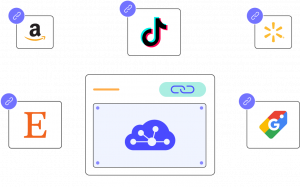Imagine running an online store without worrying about inventory, packaging, or shipping. That’s the beauty of dropshipping with Shopify! With this business model, you can sell products without holding stock, and Shopify, with a user-friendly interface and a wide range of features, makes it easy to set up, manage, and scale your store. Wonder how to jumpstart this journey? In this step-by-step guide, we’ll walk you through 6 steps on how to dropship on Shopify, including:
- Step 1: Find profitable dropshipping products
- Step 2: Create a Shopify store
- Step 3: Search for reliable dropshipping suppliers
- Step 4: Customize the Shopify store
- Step 5: Add products to your Shopify store
- Step 6: Market your Shopify dropshipping store
By the end of this post, you’ll have everything you need to start and grow a successful Shopify dropshipping business. Let’s get the ball rolling!
Dropship Beyond Shopify!
With LitCommerce, you can easily list your Shopify dropshipping products on various marketplaces like eBay, Amazon, and Etsy to reach more buyers and sell more.
What is Shopify Dropshipping?
Shopify dropshipping is a business model where you sell on Shopify without inventory or worrying about packaging or shipping. Instead, you partner with dropshipping suppliers. When a customer places an order in your Shopify store, you forward it to your suppliers, who then ship it directly to the customer.
This business model lets you focus on marketing and customer service while the supplier handles stock, packaging, and shipping. Moreover, Shopify is one of the best eCommerce platforms for building an online store, even if you have no tech skills. It’s easy to set up and offers customizable templates, integrated payment options, and plenty of apps. Simply put, a Shopify dropshipping business is cheap and easy to start, pretty much risk-free, and offers various products. It allows you to start, automate, and grow your Shopify dropshipping store quickly and effectively.
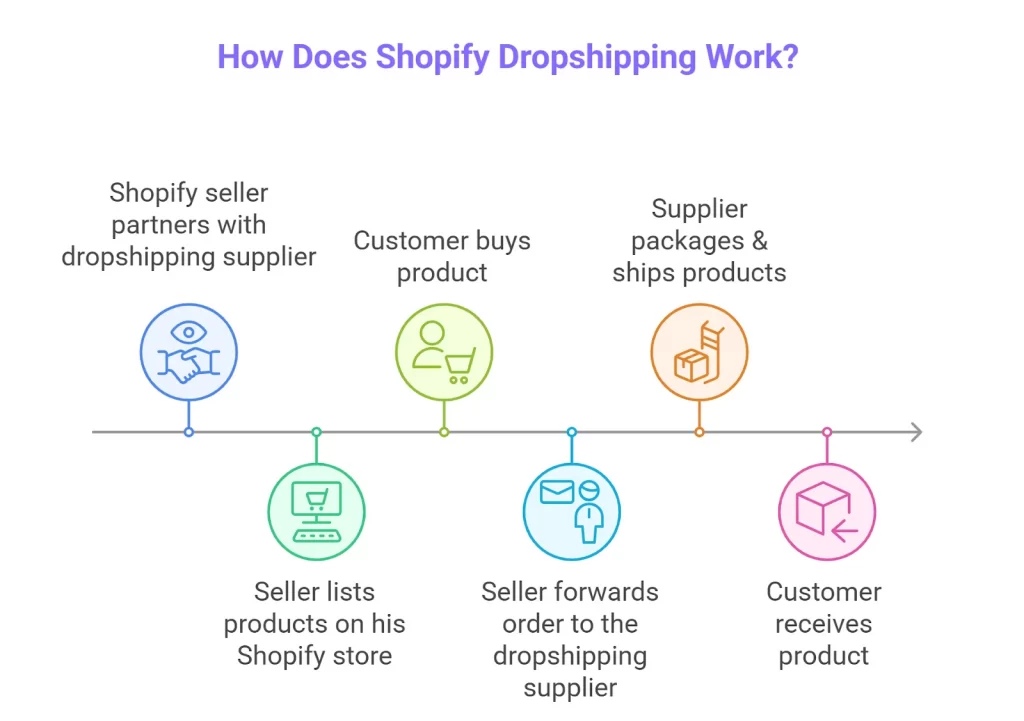
However, before finding out “How to dropship on Shopify for beginners,” keep in mind that the biggest challenge for a dropshipper is finding reliable suppliers that represent your brand’s values and quality. Thus, it’s worth investing time in testing your products to ensure quality and brand alignment. Additionally, Shopify has monthly fees, transaction fees, and probably extra app costs, so factor these into your expenses to run your dropshipping store.
How to Dropship on Shopify: A 6-Step Guide in 2025
Now that we’ve covered the basics of dropshipping on Shopify, building a business may seem so big, but taking it step by step makes it achievable. Let’s break it down and turn your business idea into reality!
To start dropshipping on Shopify, follow these 6 steps below to build your business!
Step 1: Find profitable dropshipping products
To start, find the right product to dropship on Shopify. Your product choice plays a huge role in your success – high-demand items attract more customers and drive consistent sales. A well-chosen product can set your store apart in a competitive market and maximize your profits.
A winning product should have:
- A “Wow” factor or problem-solving ability: The product should be unique, visually appealing, or solve a common issue to attract buyers.
- Healthy profit margins: Aim for 2.5x to 3x the source price, with at least a $20 gross margin to cover marketing costs and ensure profitability.
- Not easily found in local stores: Unique or hard-to-find items perform better, as they create a sense of exclusivity and reduce direct competition with retail stores.
- Reasonable shipping & handling: Because you’re relying on third-party suppliers for shipping, heavy or fragile products can result in higher shipping costs and more potential for damaged goods during transit, leading to unhappy customers and returns.

To find profitable products to dropship with Shopify, some of the top tools and methods to use are Google Trends, Amazon Best Sellers, AliExpress Dropshipping Center, or ChatGPT. You can also search for product ideas on social media, such as TikTok Trends.
While T-shirts are a top choice for dropshippers, some other popular dropshipping products are pillows, mugs, sleepwear, yoga mats, stainless steel tumblers, or organic baby clothing. Beauty and personal care products are also trending and in high demand in 2025, so you also consider vitamins, skin care oils, and body wash to dropship on Shopify.
Step 2: Create a Shopify dropshipping store
After finding your dropshipping product ideas, let’s create your Shopify store. Shopify currently offers a 3-day free trial, followed by 3 months at just $1 per month. This gives you time to set up your store and explore the platform before committing to a paid plan.
Here’s the Shopify tutorial on how to set up a Shopify store for dropshipping:
- On the Shopify homepage, click Start Free Trial.
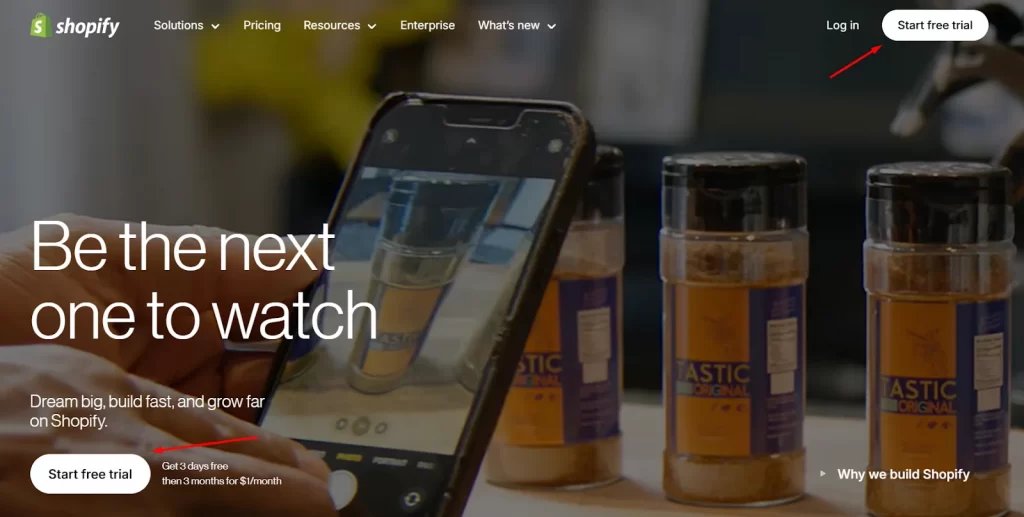
- Select your location in the menu.
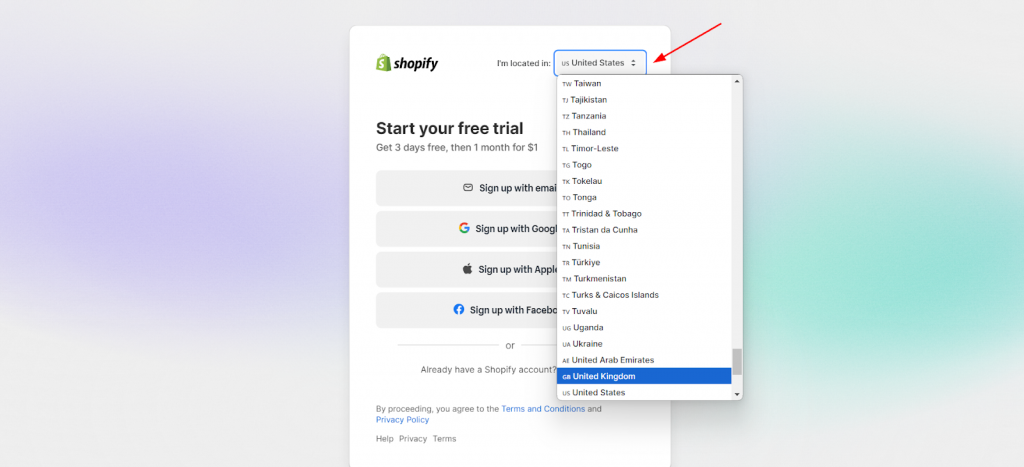
- Choose Sign up with email or any other option to create a Shopify account. Then, fill in basic information about your business.
- Next, name your Shopify dropshipping store. A good brand name can help your business stand out from the competition.
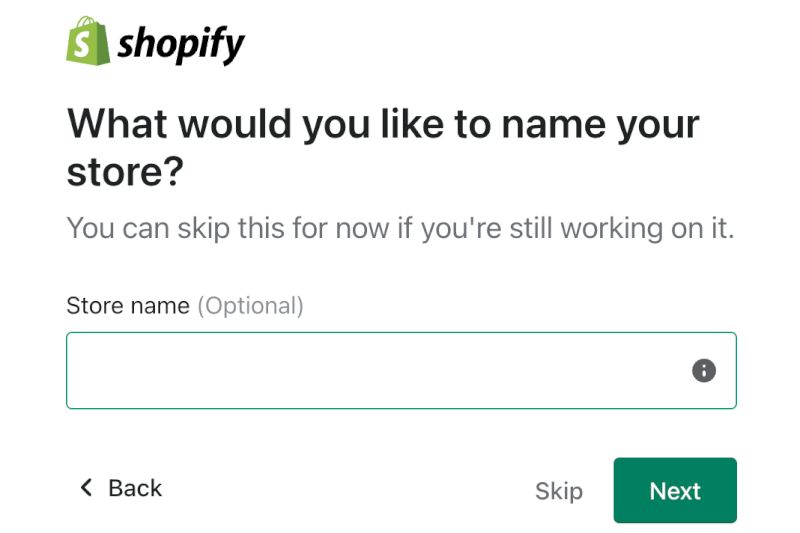
Here are some insightful tips to help you name your dropshipping store:
- Use relevant keywords
- Make it unique but also easy to pronounce and remember
- Think globally
- Check domain availability
There are plenty of business name generators to generate your store name, or you can also use AI tools like ChatGPT or Gemini to speed up this naming process.
- Connect your domain name: A domain is the URL or web address where your customers go to find your store online. By default, your Shopify store was given a myshopify.com URL. However, using your own domain, for example, lapetitelibraire.com instead of lapetitelibraire.myshopify.com, is far more professional, credible, trustworthy, and better for SEO. When choosing a custom domain, it’s important to keep it short, memorable, and reflective of your brand identity.
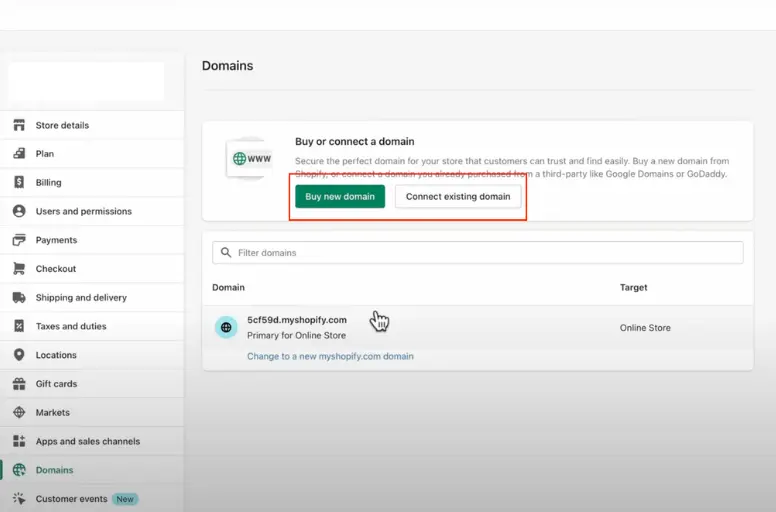
6. Add your Shopify dropshipping logo: A well-designed logo enhances your brand’s visual identity and helps it stand out from competitors. To make the process easier, you can use the best design tools or logo generators, like Canva, Adobe Illustrator, or Looka (AI-powered logo generation with various customization options).
Step 3: Search for reliable suppliers
Finding a trustworthy dropshipping supplier is crucial to ensure that your orders are well-packed and delivered to your customers. There are three main ways to find and connect with reliable suppliers when you look for how to dropship on Shopify.
1. Use dropshipping apps on Shopify
Shopify integrates with various dropshipping apps that connect you directly with suppliers worldwide. These apps allow you to browse products, compare pricing, and automate order fulfillment. Many also include supplier reviews to help you evaluate reliability before adding products to your store. Popular options include:
- DSers – Best for sourcing from AliExpress suppliers.
- Spocket – Connects with US and European suppliers for faster shipping.
- Modalyst – Offers branded and high-end products.
- Zendrop – Provides custom branding and packaging options.
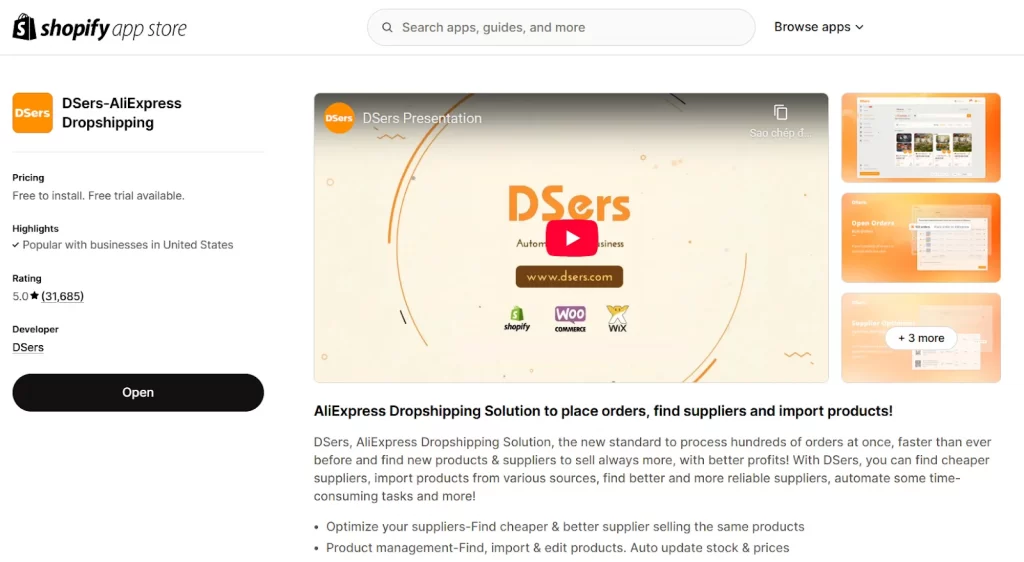
2. Contact suppliers directly (traditional method)
For a more hands-on approach, you can reach out to wholesale suppliers and manufacturers directly. This method allows you to:
- Negotiate pricing and shipping terms to maximize profit margins.
- Ensure product quality by requesting samples before selling.
- Build a long-term partnership with suppliers that align with your brand values.
Use platforms like AliExpress, Alibaba, or ThomasNet to find verified suppliers, and always check reviews and response times before committing.
3. Use Shopify Collective
Shopify Collective is a built-in marketplace that lets you sell products from other Shopify merchants in your store. This is a great option if you want to:
- Offer high-quality, vetted products without dealing with third-party suppliers.
- Ensure faster shipping since products come from existing Shopify sellers.
- Simplify inventory management by dropshipping from fellow merchants.
Regardless of the method you choose, here are some criteria that you should consider when choosing your supplier:
- Evaluate the supplier’s reputation and credibility through reviews, ratings, and background research;
- Consider the supplier’s pricing, shipping times, and available inventory;
- Review the supplier’s policies on returns, refunds, and exchanges;
- Ensure the supplier is responsive and provides clear communication.
Step 4: Customize your Shopify store
After finding your dropshipping partner, it’s time to customize your Shopify store by choosing a theme that reflects your brand’s aesthetic and values and then editing it.
Navigate to the theme editor from your dashboard by going to Online Store > Themes. Next, locate your chosen theme and click Customize.
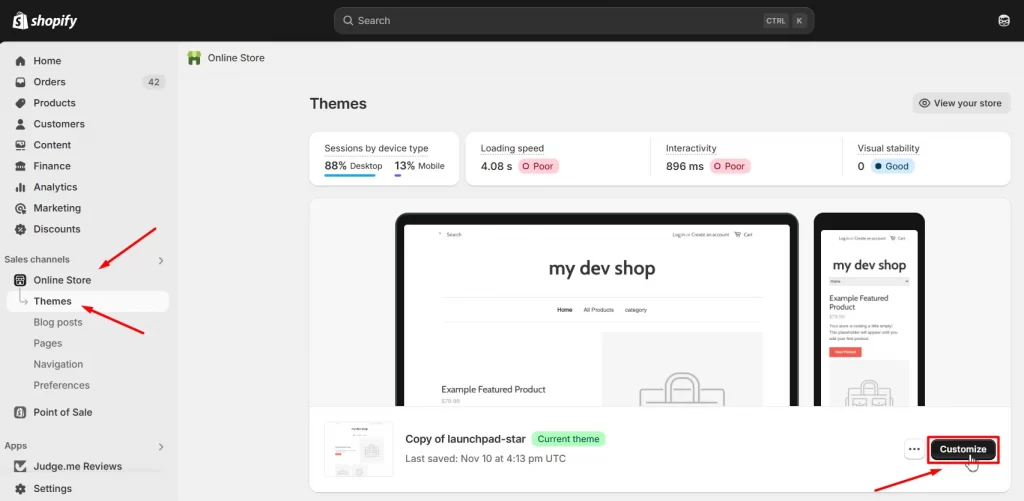
If you’re looking for free themes and apps, check out LitCommerce’s articles on the best free Shopify themes.
Step 5: List dropshipping products on Shopify
In this step, let’s learn how to add dropshipping products on Shopify, there are two main options to list products:
Option 1: Creating new product listings within Shopify.
For how to dropship on Shopify guide, here are the step-by-step instructions to manually add new products on Shopify:
- Step 1: Navigate to the Products section in your Shopify admin panel and click on Add Product

- Step 2: Fill in the details for each item, including title, description, images, and pricing.
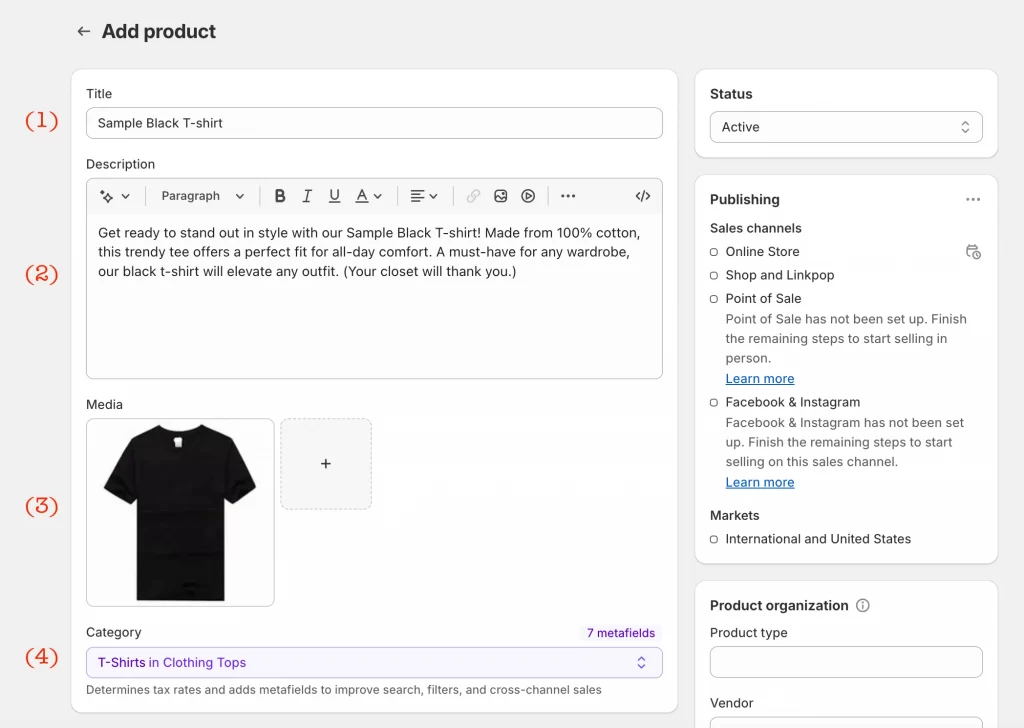
- Step 3: After that, quickly review all the information of new items and click Save product to enable Shopify product visibility.
Import Products to Shopify Faster with BulkFlow
Have a file from your supplier? Use BulkFlow to import products directly from your supplier’s file, whether it’s CSV, Excel, or Google Sheets. No more listing one-by-one.
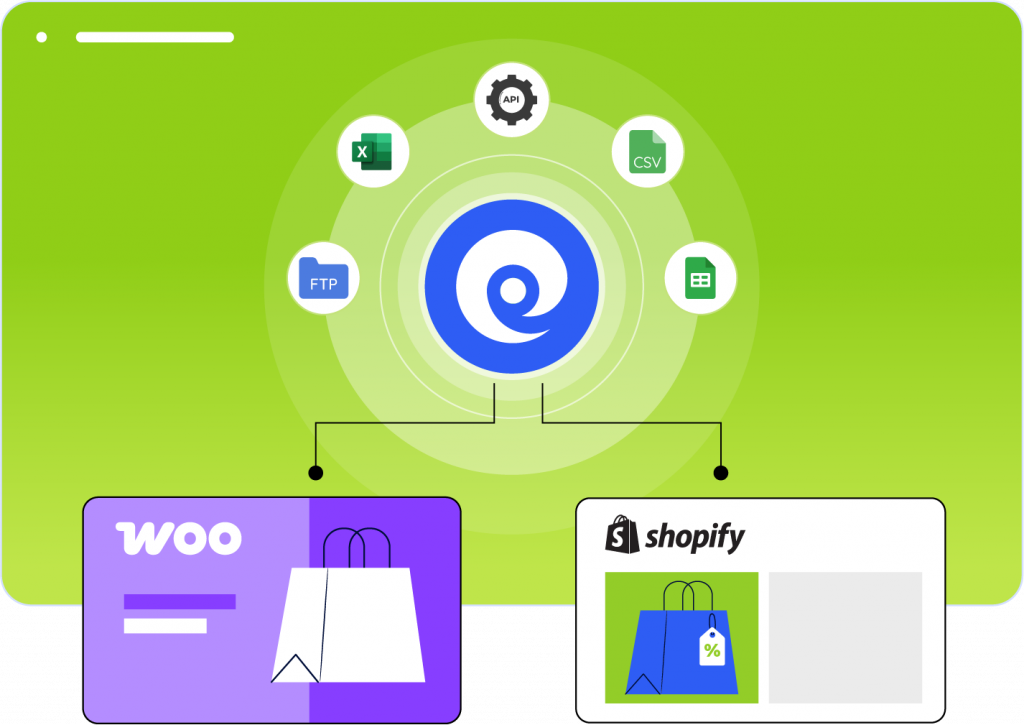
Option 2: Importing products from another platform.
When looking for how to set up dropshipping on Shopify, if you have already placed your product information in another eCommerce platform, you may not choose to add products to Shopify manually. Using sourcing apps from fulfillment suppliers, you can import the product listings from the source. For example, if you use DSers to source products from AliExpress, you can import listings with all the text, images, etc., from there.
Additionally, suppose you already have existing listings on another platform, such as Etsy or Amazon. If you’re wondering how to dropship Amazon products on Shopify, you can use a service like LitCommerce to import those listings to your Shopify store easily. It is a popular Shopify integration that offers seamless store connection with Shopify, allowing you to easily sync your existing product listings and manage them all from one central location.
Start dropshipping on multiple platforms today!
LitCommerce saves your time and streamline operations by importing your listings directly to Shopify
Step 6: Market your dropshipping store
Now comes the critical step of how to dropship on Shopify, which is building a strong marketing strategy to drive traffic to your Shopify store and generate sales. Using a mix of free and paid strategies can help drive traffic, increase sales, and build brand awareness.
Free marketing strategies:
- Short-form video content: Platforms like TikTok, Instagram Reels, and YouTube Shorts are powerful tools for reaching potential customers. Order a sample product and create engaging videos to showcase its features. Experiment with different styles to find what resonates with your audience.
- Start a blog: A blog is a cost-effective way to attract organic traffic. Share product insights, industry trends, and how-to guides to establish credibility.
- SEO: You can improve your store’s visibility and attract more organic traffic by implementing effective SEO strategies. This can be achieved through keyword research, optimizing product descriptions and titles, building backlinks, and other techniques.
- Email marketing: With email marketing, you can reach out to potential customers directly and promote your products through targeted campaigns. You can start by building an email list of interested subscribers using pop-ups, opt-ins, and lead magnets on your website.
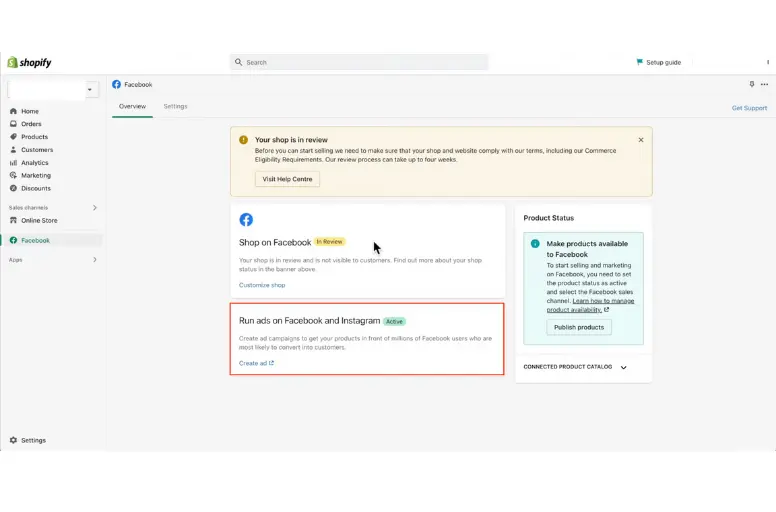
Paid marketing strategies
- TikTok Ads: Leverage TikTok’s engaging format with product demos, trending challenges, and problem-solving videos to capture attention and drive sales. Plus, the key to successful TikTok ads is keeping your videos short, engaging, and native to the platform.
- Instagram & Facebook Ads: Use precise audience targeting to reach potential buyers based on interests, behaviors, and demographics.
- Google Ads: You can also make your products appear at the top of search results by running Google Shopping and search ads to attract high-intent buyers.
How Much Does It Cost to Start Dropshipping on Shopify?
After spending hours researching, the minimum cost to start selling is approximately $280 to $300 per month. However, we recommend starting with a budget of $500 to $1,000 for better flexibility and growth potential.
To be more clear, below is the breakdown of fee structures:
Expense | Cost Range (Minimum) |
Business Registration and Licensing Fees | $50 – $100 |
Domain name | $10 – $20/year |
Maintain store | $29 – $79/month |
Setup store | $0 – $200/month |
Marketing Costs | $200+/month |
Dropshipping Tools/Apps | $1 – $29/month |
Payment Transaction Fees | $0.30 per transaction |
This includes minimal costs for each essential component, focusing on budget-friendly options for hosting, ads, and tools. To better start dropshipping on Shopify, we recommend that you follow this budget structure:
- Allocate 70% to marketing
- Keep 20% for unexpected costs
- Save 10% for optimization
How to Dropship on Shopify – FAQs
Yes, dropshipping on Shopify can be profitable. Many store owners make $1,000 to $5,000 per month, and top sellers earn over $100,000 a year. Shopify’s easy-to-use platform, automated tools, and dropshipping apps help you start and grow your business without managing inventory. With the right products and marketing, you can build a successful store. Starting dropshipping on Shopify is simple. Follow these steps: Starting dropshipping on Shopify with $100 is possible but challenging. You can begin with Shopify’s $1 monthly trial and work with low-cost suppliers or those that don’t require upfront fees. Your main expenses will be your domain, marketing, and product testing. To keep costs low, use a free Shopify theme, focus on organic marketing (social media, SEO), and set up your store yourself. Yes, Shopify is a popular platform for setting up a dropshipping business. You can dropship from a Shopify store by using a dropshipping app or by manually adding products from a supplier to your store. Shopify is not completely free for dropshipping. While there is a free trial period available, you will need to subscribe to one of Shopify’s plans to continue using the platform. However, the cost of a Shopify subscription is relatively affordable and includes features like website hosting, payment processing, and customer support. No, Shopify itself does not charge you for dropshipping. However, you will need to pay for any third-party apps or services you use to facilitate your dropshipping business. Additionally, you will need to pay for the cost of your products and any associated shipping and handling fees.
Start Dropshipping on Shopify Today!
We hope this guide has provided you with valuable insights into how to dropship on Shopify, from creating your Shopify dropshipping store, to finding your product niche and marketing your products effectively.
If you’re looking for an easy and effective way to import your existing listings from other platforms to Shopify, be sure to check out LitCommerce. Our platform can help simplify the migration process and make it easier for you to manage your products and orders.


